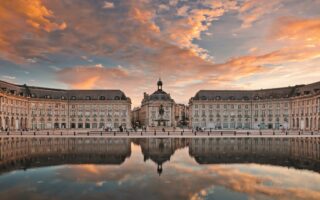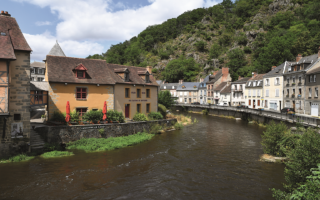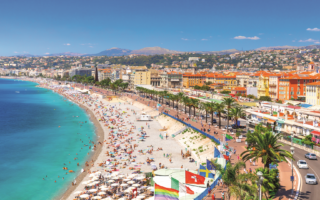Property Montpellier – Herault
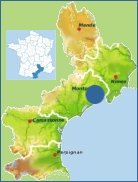

Guide to property prices and trends in Montpellier
• Montpellier Property for Sale
Montpellier is, for those who have never been there, simply a stunning and beautiful place to live. Set under the warm Mediterranean sun of the South of France, under piercing blue skies most of the year, situated close to the sea, this is the French city that more French people want to live in than any other. It is “bien situé” as they say here. It has three sandy beaches, Palavas-les-Flots, La Grande Mottte and Carnon-Plage within half and hour from its centre; it reputedly rains even less on Montpellier than nearby Nîmes; just outside its main commuter belt there are rolling vineyards and pretty medieval villages; and it is less than three hours by car from skiing in the Cevennes.
Architecturally, Montpellier is gorgeous. Its impressive Antigone sub-district near La Place de Comedie sets out Montpellier’s ambition to be the leading city of the Mediterranean in France. It is a theatre of architecture, of wide-open space, squares, fountains, and magnificently sized buildings, all built in a discrete modern neo-classical style. It’s hard to imagine that this is in fact a large housing estate! Indeed Montpellier is divided into seven main districts, which are in turn again divided into sub-districts, each having its own character and identity. For example Montpellier-centre is home to both the historical old quartier – where one can find boutiques, bistros, bookshops and curios tucked away down narrow lanes – and the futuristic Antigone; a visual metaphor for how Montpellier strives to move ever forward whilst honouring her past.
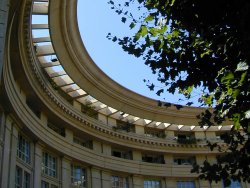
detail of architecture at Antigone
.jpg)
a street in Montpellier’s old quartier
Reflections on Montpellier’s past show that there has always been an element of independence and defiance here. At the time of the Reformation in the sixteenth century, many of the inhabitants of Montpellier became Protestants (or Huguenots as they were known in France) and the city became a stronghold of Protestant resistance to the Catholic French crown until 1622, when Louis XIII besieged the city and took it after eight months struggle. After the French Revolution, the city became the capital of the Hérault department and then, in more recent history, was confirmed as the capital of the Languedoc-Roussillon region. It was during the 19th century that the city started to really grow in importance as it developed into an industrial centre attracting economic migrants from across the region. This, and the fact that in the 1960s its population grew dramatically after French settlers in Algeria were resettled in the city following Algeria’s independence from France, has given birth to the modern cosmopolitan city of Montpellier.
Economically, Montpellier is now cited as the most dynamic city in the south of France. Employment grew by an enviable 17% between 1990 and 1999 compared to just 4% for Nîmes in the same period. Montpellier is the centre of young high tech industries (global companies such as IBM and Dell have bases there), and owing to its universities, it is a centre for excellence in learning and industry. The population of the commune of Montpellier at the 2006 census was 251,392, whereas the whole metropolitan area had a population of 600,000, not including the vast non local student population. The number of young people, the economic dynamism, and the universities give Montpellier the air of a young, fashionable and exciting place to live. Estimates are that Montpellier is set to double in population over the next 10 years. In recent years the city has forged ahead with more groundbreaking eco-friendly advances, such as the installation of the very well-received new two-line TaM tram system (a third line is due for completion in 2012) and the Vélomagg public bicycle rental system.
Culturally, Montpellier is, like most cities, well equipped with events, festivals, museum and art exhibitions, fine dining, cinema and music festivals. Amongst the annual cultural highlights is the Radio France Festival; established in Montpellier since 1985, it has now become one of France’s biggest classical and contemporary music festivals featuring over 150 concerts. In 1997 the city was also voted the most sporting of all the cities of France by the newspaper “L’Equipe”, with every possible facility from rugby to horse riding to ice-skating. In 2007 this was confirmed when Montpellier hosted the Rugby World Cup.
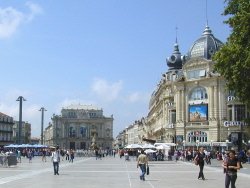
from wide open space at Place de la Comédie
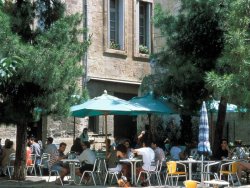
to smaller more intimate squares
The rise and rise of Montpellier in recent years has seen a significant rise in property investors tipping the city as the next big thing. Indeed, the FNAIM* statistics showed a rise of 15.1% in property prices between 2000 and 2005, with the average square metre valued at €2702 in 2005. But has the recent economic crisis has any effect on Montpellier’s bankability? The January 2008 FNAIM report showed that prices per square metre in Montpellier had risen to a staggering €2783 by the fourth quarter of 2007, a 3.6% annual increase. However the January 2009 FNAIM report shows that the times are finally catching up to Montpellier, albeit with a relatively small drop of 0.2% for the last quarter of 2008, with the average square metre now valued at €2776. However, this is still markedly cheaper than cities in the neighbouring Mediterranean coastal regions of Provence and Côte d’Azur, which have also seen much larger price drops; in 2008 Marseille saw a 3.1% drop in prices to €2930 per square metre and Nice has seen a 2% drop to €3861 per square metre. The statistics suggest, then, that the city of Montpellier is holding its property values better than others.
So currently buyers should be looking at budgeting around €45,000 – €70,000 for a studio apartment and up to €300,000 for a three or four bedroom apartment with terrace in a nice area. The demand for small apartments is high as a result of the student population, and good quality student accommodation is scarce. Also those interested in buying a property for holiday letting on the coast could maximise their revenue by attracting year round rents from the student population if they bought one in commuting distance from Montpellier. Similarly, as the commuter belt expands, properties in the pretty villages around Montpellier are attracting families looking to escape the big city whilst still being within easy reach of it. Villas in the Montpellier area start at around the €150,000 for two or three bedrooms with reasonable sized gardens. However, if your budget can reach beyond €350,000 you are likely to pick up a very nice property, with space, pool and garden in an attractive district.
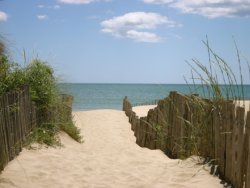
the Mediterranean is within half an hour
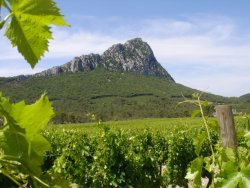
vineyards and hills around Montpellier
Montpellier remains one of the most popular cities to buy in today. A study published in April 2009 by French mortgage specialists Crédit Foncier determined that Montpellier is one of just eight cities in France most likely to withstand a fall in property prices in the French market, making Montpellier a relatively safe bet going forward. It is true that you are unlikely to see such dramatic price rises as those seen in the first half of the decade, but it seems unlikely that prices will drop as much here as in other areas. And, finally, when all is said and done you simply have to ask yourself: who wouldn’t want to live in one of the sunniest, youthful, and exciting places in the South of France?
Greca Sandford
Certain photos in this article are copyrighted to the Montpellier Office de Tourisme, and may not be reproduced without permission.
• Click here for Montpellier Property for Sale featured on FrenchEntrée.
* Fédération Nationale de l’Immobilier – National Estate Agents Federation
Share to: Facebook Twitter LinkedIn Email
More in beach, centre, estate agents, garden, guides, holiday accommodation, villages
By FrenchEntrée
Leave a reply
Your email address will not be published. Required fields are marked *

